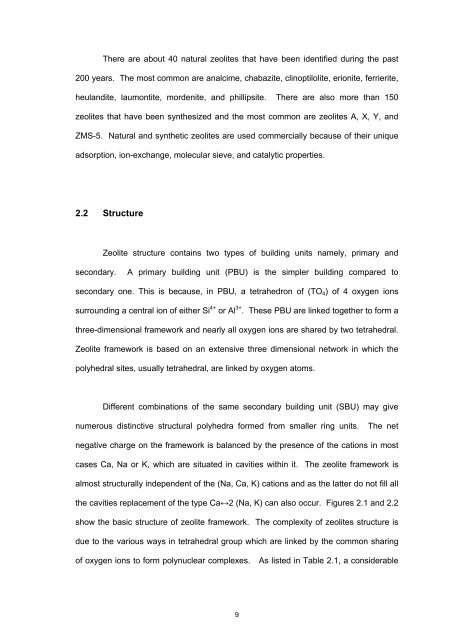SYNTHESIS AND CHARACTERIZATION OF ... - ePrints@USM
SYNTHESIS AND CHARACTERIZATION OF ... - ePrints@USM
SYNTHESIS AND CHARACTERIZATION OF ... - ePrints@USM
Create successful ePaper yourself
Turn your PDF publications into a flip-book with our unique Google optimized e-Paper software.
There are about 40 natural zeolites that have been identified during the past200 years. The most common are analcime, chabazite, clinoptilolite, erionite, ferrierite,heulandite, laumontite, mordenite, and phillipsite. There are also more than 150zeolites that have been synthesized and the most common are zeolites A, X, Y, andZMS-5. Natural and synthetic zeolites are used commercially because of their uniqueadsorption, ion-exchange, molecular sieve, and catalytic properties.2.2 StructureZeolite structure contains two types of building units namely, primary andsecondary. A primary building unit (PBU) is the simpler building compared tosecondary one. This is because, in PBU, a tetrahedron of (TO 4 ) of 4 oxygen ionssurrounding a central ion of either Si 4+ or Al 3+ . These PBU are linked together to form athree-dimensional framework and nearly all oxygen ions are shared by two tetrahedral.Zeolite framework is based on an extensive three dimensional network in which thepolyhedral sites, usually tetrahedral, are linked by oxygen atoms.Different combinations of the same secondary building unit (SBU) may givenumerous distinctive structural polyhedra formed from smaller ring units. The netnegative charge on the framework is balanced by the presence of the cations in mostcases Ca, Na or K, which are situated in cavities within it. The zeolite framework isalmost structurally independent of the (Na, Ca, K) cations and as the latter do not fill allthe cavities replacement of the type Ca↔2 (Na, K) can also occur. Figures 2.1 and 2.2show the basic structure of zeolite framework. The complexity of zeolites structure isdue to the various ways in tetrahedral group which are linked by the common sharingof oxygen ions to form polynuclear complexes. As listed in Table 2.1, a considerable9
















